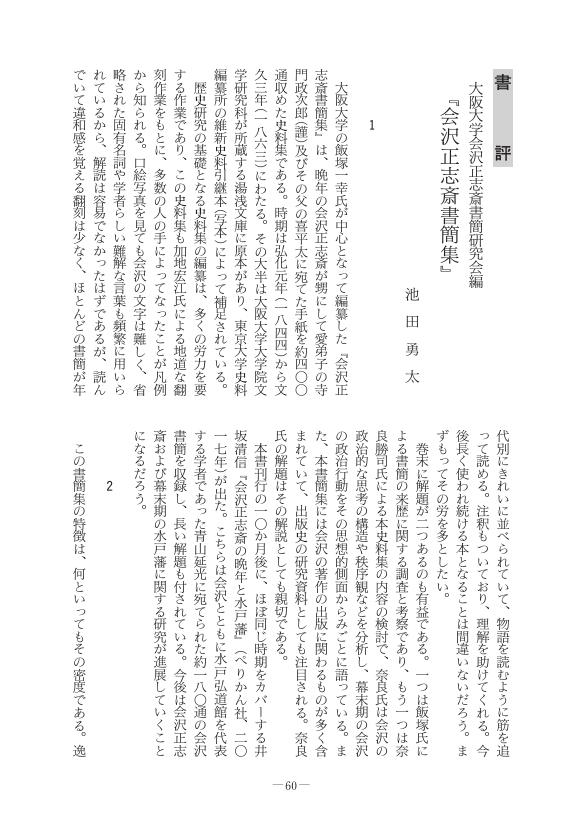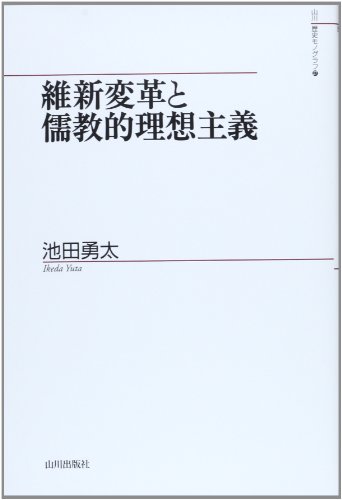10 0 0 0 IR 元田永孚における開国論への転換
- 著者
- 池田 勇太
- 出版者
- 山口大学人文学部異文化交流研究施設
- 雑誌
- 異文化研究 (ISSN:18819281)
- 巻号頁・発行日
- vol.11, pp.54-67, 2017
10 0 0 0 公議輿論と万機親裁 : 明治初年の立憲政体導入問題と元田永孚
- 著者
- 池田 勇太
- 出版者
- 公益財団法人 史学会
- 雑誌
- 史学雑誌 (ISSN:00182478)
- 巻号頁・発行日
- vol.115, no.6, pp.1041-1078, 2006
The present article attempts to clarify the birth of monarchical constitutionalism on the occasion of a debate over a popularly elected parliament in 1874, by focusing on Motoda Nagazane (or Eifu) 元田永孚, who was Emperor Meiji's tutor in Confucianism. The introduction of a constitutional polity in the absence of a government not only displayed the strong character of a modernization measure and was thought to realize a political society supported by the masses and open public opinion, but also a parliament, constitution and separation of the legislative and administrative branches of government were expected to solve real problems that existed in local administration and politics at the time. The article begins with an examination of the actions taken by the Governor of Fukushima Prefecture Yasuba Yasukazu 安場保和 in order to clarify the era's parliamentary movement against the background of local administration and to argue that the fair and just nature (ko 公) of a constitutional polity was thought to be identical to traditional Confucian political ideals. Secondly, the introduction of a constitutional polity at that point in time was not the result of power politics fought along vertical, class lines, but was rather a specific political expression of what the Restoration bureaucracy thought desirable. On the other hand, the introduction of such a polity under well-meaning auspices from above also meant that the bureaucracy did not always seek broad pluralistic opinions on the subject, but rather tended to make policy decisions in a more theoretical manner. The 1874 debate over a popularly elected parliament brought the issue of mass popular political participation to the forefront in terms of "joint rule by king and citizen." It was here that Motoda Eifu suggested that in a monarchical state it was necessary to make a distinction between "public opinion" and "the just argument," arguing that it was the monarch who should employ the latter. Any parliamentary system in which the monarch enjoys ultimate prerogative, moreover, demands that the monarch have the ability to exercise that prerogative properly, which necessitated the development of a system of imperial advisors and educators. At that time there was also the idea that the position of senior political advisor (genro 元老) should be created outside of the cabinet to perform such a function. Motoda, on the other hand, reformed such an idea based on the necessity of a monarch performing his duties with the final say within a constitutional polity. This is why it can be said that both monarchical constitutionalism and the establishment of the emperor's prerogative within it was born out of the 1874 debate over a popularly elected parliament.
- 著者
- 池田 勇太
- 出版者
- 公益財団法人 史学会
- 雑誌
- 史学雑誌 (ISSN:00182478)
- 巻号頁・発行日
- vol.125, no.2, pp.61-79, 2016
東京大学大学院法学政治学研究科附属近代日本法政史料センター原資料部が所蔵する「安場保和関係文書」マイクロフィルム中にある「政体」と題される史料は、政体書の草案であると考えられる。慶応四年三月に起草され、執筆者は副島種臣と推定される。ただし、なぜ安場家文書中にこの史料があるのかは不明である。本稿では政体書作成の経緯を確認したのち、他の草案や政体書などとの条文比較を行い、本史料が政体書の草案であることを論じた。<br>本史料からは、明治政府がその最初の段階において、西洋の立憲制を参照しながら国民規模の政治参加にもとづく政治体制をつくろうとしていたことがわかる。また天皇が二十四歳になるまでは名代を置くことや、神祇官が制度のなかに書き込まれていないことなど、維新政権の性格を考えるうえで重要な構想が少なからず見られる。ただし「政体」は案としては廃棄され、もう一つの草案である「規律」を下敷きに政体書が書かれ、その過程で「政体」も参照されるという位置に置かれたと見られる。<br>従来、政体書は発布直後から議政官・行政官の兼任が行われて議政・行政を分離する原則に矛盾し、議政官下局も有名無実の議事機関となっていた状況が指摘されてきたが、「政体」に書かれた議会制度構想を念頭に置くと、政体書が高邁な理想をかかげつつも、草案より現実に即したかたちで書かれていたことがわかる。また、戊辰戦争で国内の形勢がほぼ固まった慶応四年冬以降、明治政府によって試みられた議会制度の導入についても、「政体」の影響が考えられる。明治政府発足当初の立憲政体導入の試みについて、再考を迫る史料と言えるだろう。
7 0 0 0 「感情体制」と生きられた感情―エゴドキュメントに見る「近代性」
本研究計画の目的は、近代社会において合理主義が進むなかで、にもかかわらず(あるいは、だからこそ)感情や情動といった「非合理的」とされる要素が果たす役割やそれが起動するメカニズムを明らかにすることである。具体的には、「感情体制」というマクロな構造を視野に入れつつ、エゴドキュメントという史料をもとにミクロにそのメカニズムを解明する。第一に19世紀の国民国家形成期と、20世紀前半の大衆社会や総力戦の時代の日本とドイツにおける多層的な「感情体制」のありようを明らかにする。第二に、多様なエゴドキュメントの分析を通じて、感情や直感が必要とされ人々の行動基準となっていくメカニズムを解明する。
5 0 0 0 IR 元田永孚の「自主自由」論
- 著者
- 池田 勇太
- 出版者
- 東京大学大学院人文社会系研究科・文学部日本史学研究室
- 雑誌
- 東京大学日本史学研究室紀要
- 巻号頁・発行日
- no.10, pp.193-214, 2006-03
論文
2 0 0 0 OA 公議輿論と万機親裁 : 明治初年の立憲政体導入問題と元田永孚
- 著者
- 池田 勇太
- 出版者
- 公益財団法人 史学会
- 雑誌
- 史学雑誌 (ISSN:00182478)
- 巻号頁・発行日
- vol.115, no.6, pp.1041-1078, 2006-06-20 (Released:2017-12-01)
The present article attempts to clarify the birth of monarchical constitutionalism on the occasion of a debate over a popularly elected parliament in 1874, by focusing on Motoda Nagazane (or Eifu) 元田永孚, who was Emperor Meiji's tutor in Confucianism. The introduction of a constitutional polity in the absence of a government not only displayed the strong character of a modernization measure and was thought to realize a political society supported by the masses and open public opinion, but also a parliament, constitution and separation of the legislative and administrative branches of government were expected to solve real problems that existed in local administration and politics at the time. The article begins with an examination of the actions taken by the Governor of Fukushima Prefecture Yasuba Yasukazu 安場保和 in order to clarify the era's parliamentary movement against the background of local administration and to argue that the fair and just nature (ko 公) of a constitutional polity was thought to be identical to traditional Confucian political ideals. Secondly, the introduction of a constitutional polity at that point in time was not the result of power politics fought along vertical, class lines, but was rather a specific political expression of what the Restoration bureaucracy thought desirable. On the other hand, the introduction of such a polity under well-meaning auspices from above also meant that the bureaucracy did not always seek broad pluralistic opinions on the subject, but rather tended to make policy decisions in a more theoretical manner. The 1874 debate over a popularly elected parliament brought the issue of mass popular political participation to the forefront in terms of "joint rule by king and citizen." It was here that Motoda Eifu suggested that in a monarchical state it was necessary to make a distinction between "public opinion" and "the just argument," arguing that it was the monarch who should employ the latter. Any parliamentary system in which the monarch enjoys ultimate prerogative, moreover, demands that the monarch have the ability to exercise that prerogative properly, which necessitated the development of a system of imperial advisors and educators. At that time there was also the idea that the position of senior political advisor (genro 元老) should be created outside of the cabinet to perform such a function. Motoda, on the other hand, reformed such an idea based on the necessity of a monarch performing his duties with the final say within a constitutional polity. This is why it can be said that both monarchical constitutionalism and the establishment of the emperor's prerogative within it was born out of the 1874 debate over a popularly elected parliament.
1 0 0 0 OA (書評)大阪大学会沢正志斎書簡研究会編『会沢正志斎書簡集』
- 著者
- 池田 勇太
- 出版者
- 日本史研究会
- 雑誌
- 日本史研究 (ISSN:03868850)
- 巻号頁・発行日
- vol.669, pp.60-66, 2018 (Released:2022-05-31)
1 0 0 0 維新変革と儒教的理想主義
1 0 0 0 OA 幕末の飯田藩主 : 堀親義の隠居について
- 著者
- 池田 勇太
- 出版者
- 飯田市歴史研究所
- 雑誌
- 飯田市歴史研究所年報 (ISSN:13486721)
- 巻号頁・発行日
- vol.9, pp.111-122, 2011
1 0 0 0 明治初年における木下助之の百姓代改正論について
- 著者
- 池田 勇太
- 出版者
- 公益財団法人史学会
- 雑誌
- 史學雜誌 (ISSN:00182478)
- 巻号頁・発行日
- vol.118, no.6, pp.1144-1180, 2009-06-20
This article offers an hypothesis for analyzing the process by which the ideas held by civil affairs bureaucrat Kinoshita Sukeyuki (1825-1899) about local parliamentary government were formed during the early Meiji Period. In the reforms aimed at how to govern the new nation emerging during the Restoration era, Confucian ideas were employed in an attempt to make a transition to direct rule over the people via state power and authority. However, with the replacement of feudal domains (han 藩) with prefectures and the dismantling of the feudal ownership system, the old framework for civil governance collapsed, and an increase in personal freedom occurred within a mood of autonomy and liberty, to a degree beyond anyone's initial expectations. In light of such a new situation, there were those, including Confucian intellectuals, who called for the introduction of publicly elected local assemblies. It was Kinoshita Sukeyuki who offered a plan to reorganize the villages of Karatsu Domain after the transition to direct han civil governance, based on the edification of the common people and their employment in local affairs of governance. Kinoshita, who would later propose a village system incorporating a deliberative body, which he initially thought would exclude the lower classes from the electorate, was forced by widespread popular uprisings opposed to the Restoration government measures to propose that peasant representatives (hyakushodai 百姓代) be made assembly members and that the lower class villagers (komae 小前) be included, in order to eliminate the legitimacy of other rebel groups. He came to think that 1) prefectural and national assemblies should first be indirectly elected from city ward and village assemblies and 2) edification policy should be fitted to the level of social mores by raising public sentiment. In the background to this was the assumption of an unstable structure facilitating popular rebellion, due to the sudden disappearance of feudal ownership and the rapid expansion of individual freedom within the underdevelopment of a governance system to replace feudalism. For that reason it was necessary for early Meiji civil government to smooth relations between upper and lower classes, and Kinoshita thought the answer lay in publicly elected popular assemblies. In the face of such new conditions, Kinoshita himself went through a transition from a Confucian view of civil government paternally protecting the people to raising issues about how to empower a fully matured nation. This is the chaotic background on which issues about political participation by the people were formed during the early Meiji Period.


